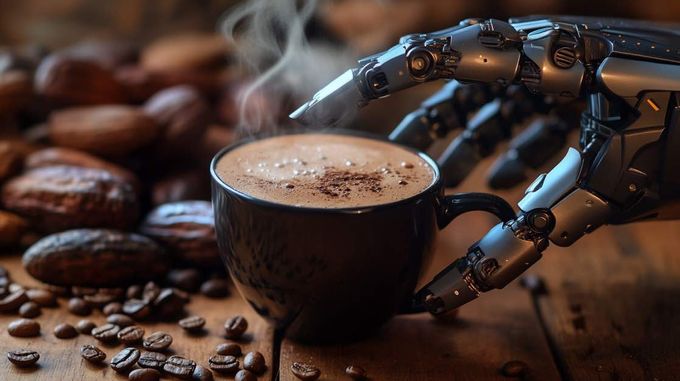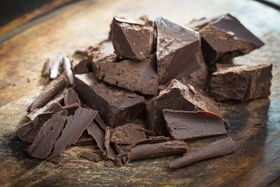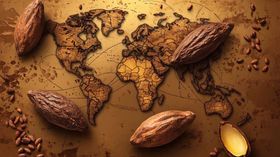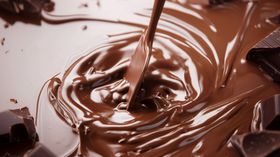How AI Is Revolutionizing Cacao and the Food Industry
Explore the cutting-edge applications of AI in the cacao and food sectors, where intelligent systems are driving efficiency, quality, and sustainability
Published February 11, 2025

Artificial intelligence has emerged as a transformative force across industries, and the food sector is no exception. Among the various food industries experiencing this technological revolution, the cacao industry stands out as a particularly fascinating case study.
From bean to bar, AI is reshaping how we grow, process, and distribute chocolate while addressing broader global food production and sustainability challenges. This represents an evolution in how we produce food and a complete shift in our approach to agriculture, manufacturing, and supply chain management.
» Explore chocolate that blends classic techniques with modern innovation
What makes AI work?
Artificial intelligence (AI) is rapidly transforming industries by enabling computers to learn, identify patterns, and make predictions or decisions at a scale far surpassing human capabilities. AI systems achieve this through several key components:
Machine learning: These algorithms sift through vast amounts of data to uncover hidden patterns and make predictions. For example, ML can analyze years of financial market data to forecast stock prices or study user behavior on a website to personalize recommendations.
Computer vision: Employing cameras and sophisticated image processing techniques, computer vision allows systems to "see" and interpret images or videos. This is used in many applications, from self-driving cars navigating complex road conditions to medical imaging software detecting anomalies in X-rays.
Natural language processing (NLP): AI and NLP work together to help computers understand and respond to human language. This allows applications like voice assistants to understand and execute commands, chatbots that provide customer support, and software that analyzes social media sentiment to gauge public opinion.
» Learn more about functional foods with our comprehensive resources
Why food and agriculture need AI
The global food and agriculture industries face unprecedented challenges, making the use of AI technologies not only beneficial but essential.
Climate change
The increasing frequency of extreme weather events has made traditional farming methods less reliable for predicting optimal planting and harvesting times. AI-powered weather prediction models now analyze vast amounts of historical and real-time data to provide farmers with more accurate forecasts and recommendations for crop management.
These systems can process information from multiple sources, including satellite imagery, ground sensors, and regional weather patterns, to create highly localized predictions that help farmers make better decisions about planting, irrigation, and harvest timing.
Quality control
Food safety and quality control have become more complex with globalized supply chains. AI systems using computer vision and sensor technologies can now detect contamination and quality issues at various stages of production, significantly reducing the risk of foodborne illnesses and product recalls.
These systems can process millions of data points in real-time, identifying potential issues before they become significant problems and ensuring consistent product quality across different production facilities and geographical locations.
» Learn more about how ceremonial cacao is created
Ethical considerations
Consumer demands for transparency in food sourcing and production have intensified, requiring sophisticated tracking systems. AI-powered blockchain solutions are now implemented to provide complete traceability from farm to table, ensuring food authenticity and ethical sourcing.
These systems can track not only product movement but also environmental conditions during transport, handling procedures, and processing methods, providing unprecedented visibility into the entire supply chain.
Reducing waste
Resource management has become increasingly critical as water scarcity and soil degradation threaten agricultural sustainability. AI systems help optimize resource usage through precision agriculture techniques, ensuring water, fertilizers, and other inputs are used only where and when needed.
This reduces costs and minimizes environmental impact while maintaining or improving crop yields.
» Ready to boost your wellness? Try functional mushroom chocolate
AI's impact across the food supply chain
AI is also extending its reach far beyond the farm. Here are just a few examples:
Smarter restaurants
AI-powered restaurant management systems are optimizing everything from menu planning to staffing. These systems analyze customer preferences to suggest popular dishes, adjust real-time pricing based on demand, and even predict busy periods to optimize staffing levels.
Furthermore, AI can fine-tune food preparation timing, ensuring orders are completed quickly and efficiently.
Seamless food delivery
Food delivery apps leverage AI to navigate the complexities of logistics. AI algorithms accurately estimate delivery times and continuously refine their predictions based on real-world data by analyzing traffic patterns, restaurant preparation times, and driver availability.
Innovative product development
AI is accelerating the creation of new food products by analyzing market trends, consumer preferences, and flavor combinations. These intelligent tools can predict which products are likely to succeed and help refine recipes before they even reach consumer testing, saving time and resources.
» Discover functional foods that nourish your body and mind
Enhanced food safety
AI-powered food safety monitoring systems are enhancing our protection against contamination and spoilage. Advanced sensors and imaging systems can detect potential issues, such as bacterial growth, chemical anomalies, or temperature control failures, before products leave the facility, ensuring higher quality and safety for consumers.
Personalized nutrition
AI is used to develop personalized nutrition plans based on an individual's genetic makeup, lifestyle, and health goals. Apps and platforms can analyze data from wearable devices and dietary logs to provide tailored recommendations for meals and supplements.
» Find out how the antioxidants in cacao improve your health
Waste reduction
From predicting crop yields to optimizing inventory management in supermarkets, AI can help minimize spoilage and ensure food reaches consumers before it expires. AI can analyze ordering patterns in restaurants to predict demand and reduce over-preparation.
Smart packaging
Smart labels can track temperature and humidity, providing real-time information about the condition of the food inside. This information can be used to optimize storage and transportation and to alert consumers when food is nearing its expiration date.
Transforming the cacao industry with AI
The cacao industry presents a unique opportunity for AI implementation due to several distinct characteristics.
- Cultivation: AI-powered precision agriculture optimizes cacao yields by using sensor networks to monitor soil conditions, moisture, and plant health in real-time and by predicting disease outbreaks like black pod rot to enable preventative action.
- Harvesting: AI transforms traditional harvesting by analyzing data to determine optimal harvest periods, using imaging systems to assess pod ripeness accurately, and employing predictive algorithms to efficiently allocate resources during peak seasons.
- Processing and production: AI improves quality control and efficiency in chocolate production. Computer vision systems can detect product defects with high accuracy and machine learning algorithms can optimize complex processes like tempering for perfect crystallization.
- Supply chain management: Blockchain-integrated AI systems revolutionize supply chain transparency by tracking cacao beans from farm to factory, verifying ethical sourcing claims, monitoring storage conditions during transport, and predicting potential disruptions.
» Indulge in the taste of 85% Peruvian chocolate from the Piura region
Challenges and limitations of AI
While promising, integrating AI in the food and chocolate industries faces significant hurdles that require careful consideration.
Key technical and data challenges
Data quality remains a fundamental concern, as AI systems can only perform as well as their training data. Agricultural conditions vary significantly by region, making it challenging to create universally effective models.
Security vulnerabilities pose real risks, as increased digitization opens systems to potential cyber-attacks that could compromise production processes or sensitive supply chain data.
AI systems can fail unexpectedly when encountering situations outside their training parameters, potentially leading to costly mistakes in production or resource management.
Practical limitations
Traditional knowledge and expertise risk being undervalued or lost as organizations transition to AI-driven processes, particularly in regions with generations of farming wisdom.
Furthermore, employment displacement presents a serious concern, especially in developing regions where cacao farming provides essential livelihoods.
AI cannot fully replicate crucial human capabilities in chocolate making, such as sensory evaluation, creative decision-making, and adapting to unexpected situations.
While AI offers powerful tools for optimization and efficiency, it works best when complementing human expertise rather than attempting to replace it entirely.
» Discover functional foods that nourish your body and mind
The human element in chocolate-making
While artificial intelligence continues to revolutionize the cacao industry, at KAICAO, the importance of preserving the human touch in chocolate production remains. We use AI to enhance rather than replace traditional chocolate making in our production.
Small-scale farming
Unlike large industrial operations that rely heavily on automation, Kaicao's partnership with small-scale farmers preserves the traditional aspects of cacao cultivation. These farmers bring generations of knowledge to their work, understanding subtle environmental cues and local conditions in ways that AI cannot fully replicate.
This hands-on approach to farming:
Creates sustainable employment opportunities in rural communities
Maintains traditional farming practices that have been refined over centuries
Allows for more careful attention to individual trees and pods
Supports local economies and preserves agricultural heritage
The art of chocolate making
While AI assists in optimizing specific processes, we recognize that creating exceptional chocolate requires human discernment and creativity. Master chocolatiers bring several irreplaceable qualities to the process:
Intuitive understanding of flavor combinations and texture
Ability to make subtle adjustments based on sensory feedback
Creative vision for developing unique chocolate varieties
Deep understanding of how different cacao origins interact with various ingredients
The result is chocolate with the distinctive character of human craftsmanship—something mass-produced, heavily automated chocolate products often lack.
Each batch tells a story of the hands that crafted it, from the farmers who tenderly cared for the cacao trees to the artisans who transformed the beans into finished chocolate.
Empowering communities
By maintaining the human element in our production process, KAICAO creates positive ripple effects throughout the supply chain:
Farmers receive fair compensation for their expertise and labor
Traditional knowledge is preserved and passed down to new generations
Local communities maintain their cultural connection to cacao cultivation
Artisanal skills continue to evolve and develop
This approach starkly contrasts fully automated production systems, where efficiency sometimes comes at the cost of community involvement and product uniqueness.
Future trends in AI and food production
The convergence of AI with food production, particularly in the chocolate industry, points to several emerging trends that will likely shape the coming decades:
- Smart fermentation technology: There is the potential for AI-powered systems using biosensors to monitor and optimize cacao fermentation in real-time by tracking microbial activity, temperature, and pH. This would lead to more consistent and desirable flavor development.
- Bioengineering and flavor prediction: AI and machine learning could be used to analyze flavor compounds in cacao. This could predict how processing affects flavor profiles, enabling precise control over taste and the creation of novel flavor experiences.
- Climate-Adaptive Agriculture: AI systems will be more likely to integrate climate modeling to predict long-term changes in growing conditions. This will help farmers adapt by recommending climate-resistant cacao varieties and optimizing planting strategies.
- Integrated Sustainability Metrics: Future AI systems will incorporate holistic sustainability metrics to measure environmental, social, and economic factors across the supply chain for more balanced and responsible production.
» Craving something different? Try dukkah and salt chocolate
Embracing technology, honoring tradition
While AI transforms industries worldwide, the chocolate sector shows how technology can amplify rather than replace human artistry. AI excels at optimization and prediction, but exceptional chocolate comes from human creativity and craft.
At KAICAO, we understand that the future of chocolate making isn't about choosing between tradition and technology—it's about finding the sweet spot where they complement each other.
We've discovered that AI works best not as a replacement for human craft but as a tool that frees our artisans to focus on what they do best: creating chocolate that tells a story and carries the unmistakable signature of human craftsmanship.
» Experience where tradition meets innovation with KAICAO chocolate
Disclaimer: The chocolate information provided by Kaicao is intended for educational purposes related to chocolate products. We encourage you to embrace the chocolate experience, savor each moment, and explore the world of chocolate with passion.






